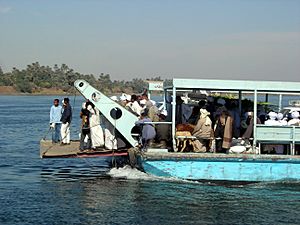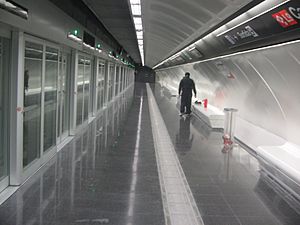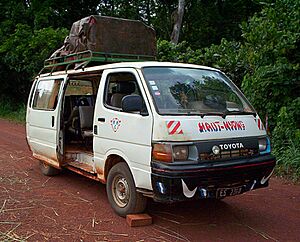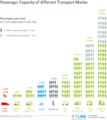Public transport facts for kids


Public transport is a way for many people to travel together without needing their own cars. It's also called public transportation in some places like the United States. This type of travel helps lots of passengers go to different places at the same time.
Contents
History of Public Transport
People have used ships to carry passengers for a very long time, even before recorded history. On land, public transport started becoming important in parts of western Europe in the early 1800s.
Around 1826, horse-drawn omnibuses began operating in Nantes, France. Omnibuses were like large carts with seats for passengers. At the same time, railroads in England started carrying people between towns. Ferries, which are public boats, also grew bigger and more common then.
Types of Public Transport
The main kinds of public transport you'll see are buses, trolleybuses, trams, and trains.
- Trams were first used in the late 1860s. Back then, horses pulled them! Today, trams are electric and run on special tracks, often with power from overhead wires.
- Buses drive on the road, just like cars.
- Trolleybuses are similar to buses, but they get their electricity from two wires above the road.
- Trains run on tracks and can be very fast, especially for long distances.
Using Public Transport
Many people who don't have cars use public transport every day. Buses, trolleybuses, and trams are great for going to places near home. Trains are often used for traveling further away. For very long trips, people might choose airlines or trains.
When you use public transport, you usually need a ticket or a special card.
- On trams, you might get a ticket and put it into a machine that shows how long it's valid.
- On buses and trolleybuses, you might buy your ticket from the driver and then put it into a machine.
- For trains, you often use a ticket to get onto the platform or the train itself.
A timetable tells you when the transport will arrive and where it's going. You can only travel when and where the public transport is scheduled to go.
Public transport is also good for our planet. When many people share one vehicle, fewer cars are on the road. This means less pollution in the air. It's also usually cheaper to use public transport every day compared to driving a car. That's why even people who own cars often choose to use public transport!
Modern Public Transport Types
Public transportation comes in many different forms around the world.
Road Transport
- Share taxis (like minibuses and maxi-taxis)
- Auto rickshaws
- Buses
- Bush taxis (common in West and Central Africa)
- Trolleybuses and electric buses
- Jitneys or Songthaews
- Limousines
- Matatus (in East Africa)
- Motor coaches
- Paratransit (special transport for people with disabilities)
- Rickshaws
- Taxicabs
- Transit buses
- Vanpools
- Vehicle for hires
- Velotaxis
- Combis (in Peru)
Rail Transport
- Automated guideway transit (AGT), also called Peoplemover
- Cable cars on rails (used in cities like a streetcar pulled by a cable)
- Cable cars on rails (used in mountains)
- Rack railways (trains that use a toothed rail for steep slopes)
- Elevated railroads (like the Chicago 'L')
- Light rail (a tram-like system, but usually on its own tracks, not shared with cars)
- Magnetic levitation trains (Maglev)
- Metro (also known as 'subway' or 'underground')
- Rubber-tired metro
- Advanced Rapid Transit
- Monorails
- Railways (including commuter trains and high-speed rail)
- Trams (tramways or streetcars)
Water Transport
- Ferry (including hydrofoils, catamarans, and hovercrafts)
- Water taxis
Air Transport
Sloped or Vertical Transport
- Aerial tramways or Aerial lifts (vehicles hanging from cables in the air)
- Chairlifts
- Conveyor transport (like escalators and moving sidewalks)
- Elevators or lifts
- Funiculars (tram-like vehicles on rails pulled by a cable up very steep slopes)
Some of these, like elevators in office buildings or school buses, are not always for the general public.
Stations and Stops

Stations are important places where public transport vehicles pick up and drop off passengers.
- Airports, Heliports
- Airport terminals
- Bus stops (including bus stations and depots)
- Metro stations
- Park and ride (places where you can park your car and take public transport)
- Ship terminals, ferry slips, piers, or wharfs
- Taxi stands
- Terminal stations (the last stop on a line)
- Railway stations
- Tram stops
For taxis, you can often get on or off anywhere stopping is allowed. Some buses let you wave them down and get on or off at unmarked spots along their route. This is called a "hail-and-ride" section.
Paying for Public Transport
Public transport systems need money to be built and to operate. This money comes from ticket sales, help from the government (called subsidies), and advertisements. If tickets cost too much, people won't use public transport. So, most systems charge passengers less than the full cost of running everything.
Sometimes, a little money also comes from renting out space for stores at stations or from parking fees. Some subway systems even earn money by letting telecommunication companies use their tunnels to run fiber optic cables.
Tickets and Fares
Most public transport systems require you to buy a ticket. You can buy tickets before your trip, when you get on, or sometimes both. Tickets can be paper, metal or plastic tokens, or electronic cards (like smart cards). Sometimes, you need to "validate" your ticket, which means marking the time you start using it. A paper ticket might be stamped, while an electronic ticket is "checked in" by tapping it.
Tickets can be for:
- A single trip (or a return trip).
- Travel within a certain area for a set time (like a day pass or a monthly pass).
The fare (price) of the ticket can depend on how far you travel or which "zone" you are in.
You might need to show your ticket at the station platform, when you get on the vehicle, or to a conductor during your ride. Some systems let you get on without showing your ticket, but a ticket controller might check it later. If you don't have a valid ticket, you might get a fine.
Multi-use tickets let you travel more than once. This includes "return tickets" for two trips, or "period cards" that let you travel as much as you want within a certain area for a specific time (like a month). Some cities sell special passes for tourists that include free public transport and discounts at attractions.
A free travel pass lets you travel for free and as much as you want. These passes are sometimes given to students, older people, children, employees, or people with disabilities.
Free Public Transport Systems
Free or Zero-fare public transport means you don't pay a ticket price. These services are paid for by other means, like taxes from the government or money from businesses. They often use smaller vehicles like buses and trams.
Several medium-sized European cities and many smaller towns around the world have made their entire bus networks free to use. It's also common to find free local shuttles or inner-city loops in many places.
Images for kids
-
Early trolley car in Newton, Massachusetts
-
Transperth bus operating in Perth, Western Australia
-
A trolley bus in front of the Baltic railway station in Tallinn, Estonia
-
A Sydney Trains A Set arriving to Flemington, New South Wales
-
A SEPTA Regional Rail train in Cheltenham, Pennsylvania, a form of commuter rail
-
The SkyTrain in Vancouver is the longest rapid transit system in Canada.
-
A streetcar in Toronto, which operates the largest tramway in North America
-
Water bus (vaporetto) at bus stop in Venice, Italy
-
A contactless ticket validator used in Moscow, Russia
-
The SmartRider is a smart card for public transportation tickets in Perth, Western Australia
-
A police officer and a police dog patrol a Moscow Metro platform
-
Traffic jam in São Paulo, Brazil
See also
 In Spanish: Transporte público para niños
In Spanish: Transporte público para niños

























